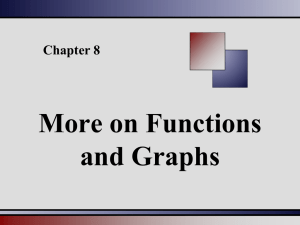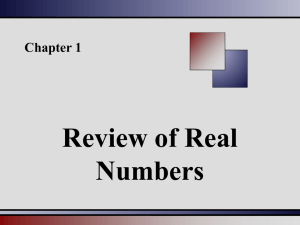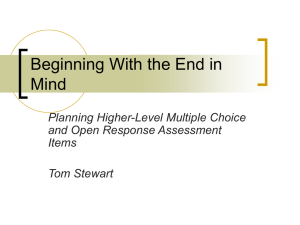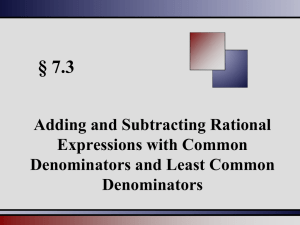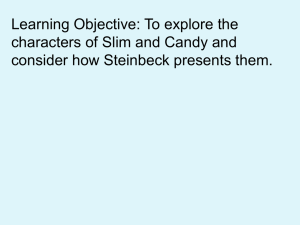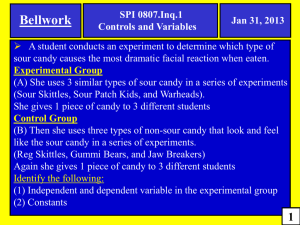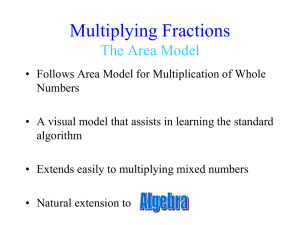Beginning & Intermediate Algebra. 4ed
advertisement
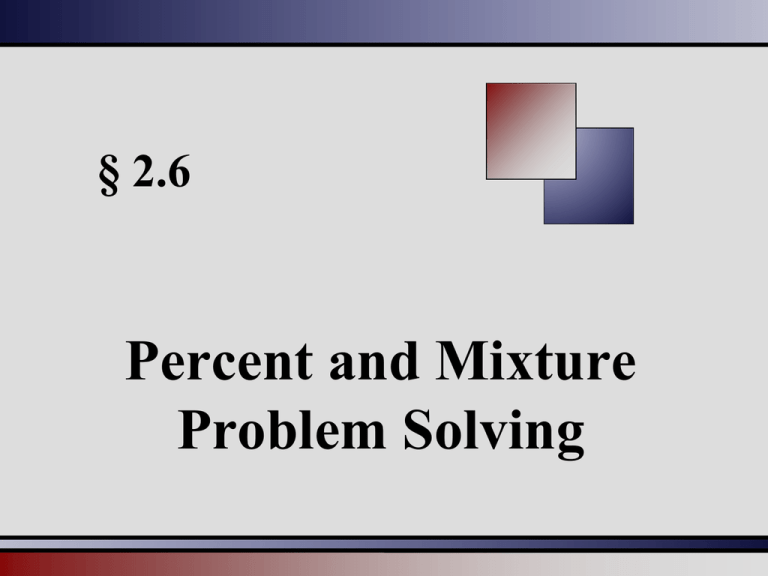
§ 2.6 Percent and Mixture Problem Solving Strategy for Problem Solving General Strategy for Problem Solving 1) UNDERSTAND the problem. • Read and reread the problem. • Choose a variable to represent the unknown. • Construct a drawing, whenever possible. • Propose a solution and check. 2) TRANSLATE the problem into an equation. 3) SOLVE the equation. 4) INTERPRET the result. • Check the proposed solution in problem. • State your conclusion. Martin-Gay, Beginning and Intermediate Algebra, 4ed 2 Solving a Percent Equation A percent problem has three different parts: amount = percent · base Any one of the three quantities may be unknown. 1. When we do not know the amount: n = 10% · 500 2. When we do not know the base: 50 = 10% · n 3. When we do not know the percent: 50 = n · 500 Martin-Gay, Beginning and Intermediate Algebra, 4ed 3 Solving a Percent Equation: Amount Unknown amount = percent · base What is 9% of 65? n = 9% · 65 n = (0.09) (65) n = 5.85 5.85 is 9% of 65 Martin-Gay, Beginning and Intermediate Algebra, 4ed 4 Solving a Percent Equation: Base Unknown amount = percent · base 36 is 6% of what? 36 = 6% · n 36 = 0.06n 36 0.06n = 0.06 0.06 600 = n 36 is 6% of 600 Martin-Gay, Beginning and Intermediate Algebra, 4ed 5 Solving a Percent Equation: Percent Unknown amount = percent · base 24 is what percent of 144? 24 = n · 144 24 = 144n 24 144n = 144 144 0.16 = n 2 16 % = n 3 2 24 is 16 % of 144 3 Martin-Gay, Beginning and Intermediate Algebra, 4ed 6 Solving Markup Problems Example: Mark is taking Peggy out to dinner. He has $66 to spend. If he wants to tip the server 20%, how much can he afford to spend on the meal? Let n = the cost of the meal. Cost of meal n 100% of n + + tip of 20% of the cost 20% of n 120% of n 1.2n 66 1.2n 66 1.2 1.2 n 55 = = = $66 $66 $66 Mark and Peggy can spend up to $55 on the meal itself. Martin-Gay, Beginning and Intermediate Algebra, 4ed 7 Solving Discount Problems Example: Julie bought a leather sofa that was on sale for 35% off the original price of $1200. What was the discount? How much did Julie pay for the sofa? Discount = discount rate list price = 35% 1200 The discount was $420. = 420 Amount paid = list price – discount = 1200 – 420 = 780 Julie paid $780 for the sofa. Martin-Gay, Beginning and Intermediate Algebra, 4ed 8 Solving Percent Increase Problems Percent of increase = amount of increase original amount Example: The cost of a certain car increased from $16,000 last year to $17,280 this year. What was the percent of increase? Amount of increase = original amount – new amount = 17,280 – 16,000 = 1280 amount of increase original amount 1280 = 0.08 = The car’s cost increased by 8%. 16000 Percent of increase = Martin-Gay, Beginning and Intermediate Algebra, 4ed 9 Solving Percent Decrease Problems amount of decrease Percent of decrease = original amount Example: Patrick weighed 285 pounds two years ago. After dieting, he reduced his weight to 171 pounds. What was the percent of decrease in his weight? Amount of decrease = original amount – new amount = 285 – 171 = 114 amount of decrease Percent of decrease = original amount 114 = 0.4 = 285 Patrick’s weight decreased by 40%. Martin-Gay, Beginning and Intermediate Algebra, 4ed 10 Solving Mixture Problems Example: The owner of a candy store is mixing candy worth $6 per pound with candy worth $8 per pound. She wants to obtain 144 pounds of candy worth $7.50 per pound. How much of each type of candy should she use in the mixture? 1.) UNDERSTAND Let n = the number of pounds of candy costing $6 per pound. Since the total needs to be 144 pounds, we can use 144 n for the candy costing $8 per pound. Continued Martin-Gay, Beginning and Intermediate Algebra, 4ed 11 Solving Mixture Problems Example continued 2.) TRANSLATE Use a table to summarize the information. $6 candy $8 candy $7.50 candy Number of Pounds n 144 n 144 Price per Pound 6 8 7.50 Value of Candy 6n 8(144 n) 144(7.50) 6n + 8(144 n) = 144(7.5) # of pounds of $6 candy # of pounds of $8 candy # of pounds of $7.50 candy Martin-Gay, Beginning and Intermediate Algebra, 4ed Continued 12 Solving Mixture Problems Example continued 3.) SOLVE 6n + 8(144 n) = 144(7.5) 6n + 1152 8n = 1080 1152 2n = 1080 2n = 72 n = 36 Eliminate the parentheses. Combine like terms. Subtract 1152 from both sides. Divide both sides by 2. She should use 36 pounds of the $6 per pound candy. She should use 108 pounds of the $8 per pound candy. (144 n) = 144 36 = 108 Martin-Gay, Beginning and Intermediate Algebra, 4ed Continued 13 Solving Mixture Problems Example continued 4.) INTERPRET Check: Will using 36 pounds of the $6 per pound candy and 108 pounds of the $8 per pound candy yield 144 pounds of candy costing $7.50 per pound? ? 6(36) + 8(108) = 144(7.5) ? 216 + 864 = 1080 ? 1080 = 1080 State: She should use 36 pounds of the $6 per pound candy and 108 pounds of the $8 per pound candy. Martin-Gay, Beginning and Intermediate Algebra, 4ed 14
